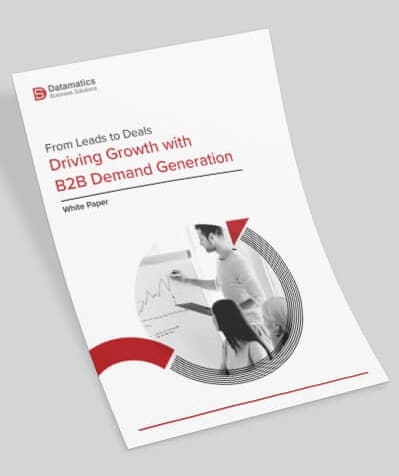You know the saying, “All roads lead to Rome”? Well, in the world of lead generation, it’s not about just getting any road to lead to your doorstep. It’s about paving the way for high quality roads that will take you where you want. Your sales team doesn’t have time to wander aimlessly down dead-end streets, and you don’t want to spend your marketing efforts on paths that lead nowhere.
When it comes to leads, quality will trump quantity, time and again. High quality leads help you make the most of your resources. Your sales team won’t waste time on dead ends, and your marketing efforts will target the right people. In this blog, we explore why quality leads matter and share tried and tested strategies to attract them. So, let’s jump in.
Identifying High Quality Leads
High quality leads are essentially those potential customers who show a real interest in what you offer and are likely to become loyal patrons. But how do you identify them amid the sea of prospects? These leads often have specific characteristics or behaviors that make them a good fit for your business. Factors like their job title, level of decision-making authority, engagement with your marketing materials, and how well they match your ideal customer profile are key indicators. In simpler terms, high quality leads are the ones most likely to buy from you and stick around for the long haul, helping your business thrive.
Here are five smart strategies B2B marketers can use to attract high quality leads:
5 Effective Tactics to Draw in High Quality Leads
1. Create Your ICP (lead characterization)
Begin by mapping out your Ideal Customer Profile (ICP) or lead characterization. Who are you really going after? Getting a clear picture of your ideal customer profile is the vital first step in pinpointing those high-quality leads for your business.
Describe the key characteristics of your ICP to help you gauge if a lead is a good fit. Further, set benchmarks for when a prospect is ready to transition into a high-quality lead who’s ready to become a paying customer.
To fine-tune your ICP, look at your past conversion data or compare your freshly defined attributes with previous sales records. This ensures you’re right on target.
Here are some attributes to help you identify your ICP:
Segmentation
- Demographic: Details about an individual, such as job title, experience, and purchasing authority.
- Firmographic: Details about the company, such as revenue, location, and existing customer base.
- Technographic: Details about a company’s technological landscape, including the technologies they use and decision-making authority within their IT department.
Engagement
This is key to understanding if a prospect is ready to take the next step. Here’s how to gauge it:
- Interaction with Content: Pay attention to how prospects engage with your online content. Are they visiting your site frequently? Do they interact with your sales team on social media or via email?
- Buyer Activity: Keep an eye on where prospects are in their buying journey. Are they downloading content that suggests they’re moving closer to making a purchase decision? These actions give insights into their level of interest and readiness to buy.
2. Discover Winning Content Types and Channels for Conversions
Gartner research reveals that companies focusing on content that aligns with past sales tend to enjoy a 12% higher sales acceptance rate. On the flip side, those who overlook the importance of tailoring content to their audience experience a 10% lower sales acceptance rate for MQLs.
That said, merely getting contacts to download content isn’t enough to label them as high-value leads. B2B marketers need to pinpoint the content types that work best and distribute them where their ideal buyers are most likely to engage with them.
Tips for Boosting Conversion Rates with Content:
- Craft Tailored Content in Clear, Actionable Language: Rather than creating broad content, break it down into smaller, task-specific pieces that address key stages of the buying process, like building requirements or selecting suppliers.
- Expand Content Touchpoints: It typically takes over 20 interactions with a prospect before they qualify as a lead for sales.
- Challenge Conventional Beliefs with Your Content: Create content around disruptive ideas that educate buyers about their industry or business. Content that questions existing practices and offers innovative solutions tends to grab attention and shows a prospect’s willingness to embrace change.
Lastly, pinpoint the marketing channels with the highest potential for capturing high quality leads. These are often the websites where your target buyers spend the most time during their buying journey, from identifying problems to reading software reviews.
Understanding which channels your buyers frequent and sourcing leads from there is a straightforward way to enhance lead quality. For instance, a software review site might be a more effective marketing channel than Facebook for engaging with B2B software and SaaS buyers.
3. Leverage Lead Scoring
Once you’ve tackled the earlier steps, tap into buyer intent data to rank your leads and enrich your ideal buyer profiles, content strategies, and channel selection criteria. Intent data provides valuable insights into individual or company behaviors, such as the websites they visit, reviews they explore on external platforms, or the content they consume.
By leveraging intent data, marketers can pinpoint potential buyers precisely when they’re actively seeking solutions. This allows for a better understanding of whether a lead has advanced enough in the buying journey to be deemed a high quality prospect.
Three ways to make the most of intent data for generating quality leads:
- Fine-Tune Your Account-Based Marketing (ABM) Approach: Use intent data to tailor your ABM strategy and focus on targeting high quality accounts.
- Customize Content to Resonate with Your Audience: Tap into intent data insights to understand what interests your prospects the most. Then, craft personalized content that speaks directly to their needs and preferences.
- Prioritize Leads with Lead Scoring:
- Leverage buyer intent data to rank your leads based on their engagement level and readiness to make a purchase. Lead scoring helps you identify which leads align best with your target buyer persona.
For B2B businesses, combining internal data sources like emails and website interactions with external buyer intent data can be a game-changer. This approach allows you to pinpoint active, high-value buyers and convert them into top-notch leads. If you need additional support in implementing these strategies, you can always partner with a lead generation services provider to maximize your results.
4. Harness the Power of “Smarketing”
Creating a seamless collaboration between your sales and marketing teams is vital for driving better conversion rates in B2B marketing. Even with well-defined buyer characteristics and lead scoring strategies, success can slip through the cracks without alignment between these two essential departments. According to Gartner, over 60% of B2B sales reps are more likely to chase after Marketing Qualified Leads (MQLs) if qualification criteria are agreed upon upfront.
Effective B2B lead generation strategies kick off with marketing and sales joining forces to craft lead qualification strategies. This teamwork entails defining what makes a lead high quality, establishing lead scoring criteria, and constantly refining these strategies based on feedback and insights.
To foster collaboration:
- Gather input from sales on lead quality and use their insights to fine-tune ideal buyer personas and define essential attributes.
- Establish a shared understanding of what qualifies as a high quality lead by digging into why marketing leads are rejected or why MQLs don’t convert.
- Regularly review and adjust lead scoring criteria alongside sales teams, keeping an eye on shifting buyer behaviors, intent data, and feedback on lead quality.
By promoting ongoing collaboration between sales and marketing, companies can streamline lead generation efforts and see a boost in overall conversion rates.
5. Measure the Impact of Quality-Based Lead Generation
Shifting your focus from sheer lead quantity to prioritizing high quality leads calls for a shift in how you measure success. Here are some key metrics to track the effectiveness of your quality lead generation efforts:
- Visitor to Leads Ratio: This metric reveals the quality of your website visitors and other digital touchpoints by showing the percentage of visitors who convert into qualified leads.
- Leads to Opportunities: Measure how many inquiries progress to become potential sales opportunities, indicating the effectiveness of your lead qualification process.
- Time to Conversions: Calculate the duration it takes for an inquiry to transform into a sale. This metric reflects the efficiency of your marketing efforts in converting prospects into paying customers.
Crafting a quality B2B lead generation funnel takes time and experimentation. As you refine your approach, identify marketing campaigns that resonate best with your target audience and drive conversions.
Categorize these successful campaigns based on ideal buyer profiles, top-performing content, or most effective marketing channels for future reference. By understanding where your best customers come from, you can replicate your success and reach similar prospects effectively.
Take the Lead
Improving sales conversions relies on snagging higher quality leads, but they don’t just drop into your lap. To reel in the cream of the crop for your business, you’ve got to roll up your sleeves and do the groundwork. That means pinpointing the perfect audience, tailoring your content to their tastes, meticulously tracking your data, and being agile enough to tweak your approach whenever necessary to maintain top-notch quality and keep those sales rolling in steadily.
But don’t worry! You don’t have to go it alone. We’re here to lend a hand and guide you through every step of the process. Reach out to us at marketing@datamaticsbpm.com, and let’s create a strategy together to supercharge your lead and demand gen efforts.
 Select an element to maximize. Press ESC to cancel.
Select an element to maximize. Press ESC to cancel.
Kent Wu


